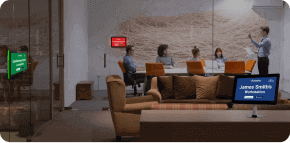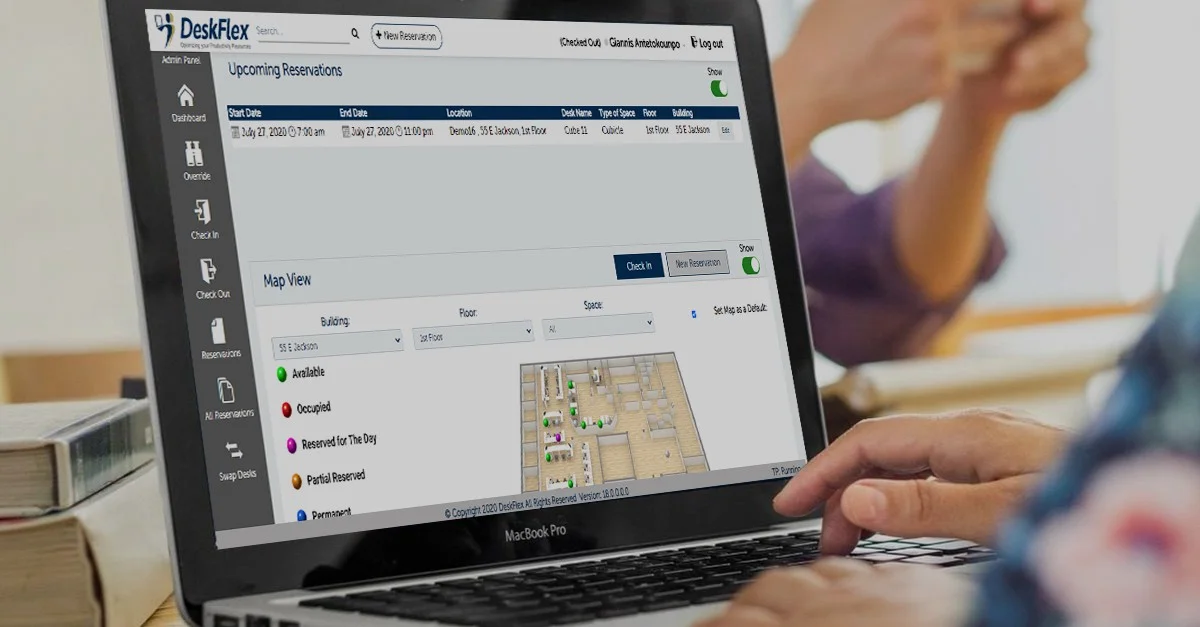Blog

How to Effectively Name Rooms at the Workplace
Naming conference rooms enhances clarity in company culture and improves office teamwork in a way that creates an environment that supports productivity and belongingness. This article will explain how structured room naming can help businesses optimize their workspace for efficiency and right engagement.
Why Naming Conference Rooms Matters
Strategically naming conference rooms is more than placing a name on a space — it’s a key tool in influencing your culture, enhancing productivity, and encouraging interaction.
A great conference room name builds a sense of place and belonging, making employees more likely to feel invested in their surroundings. It reinforces brand elements and culture by instilling values, corporate history, or industry concepts into daily activity. And clear and purposeful naming enhances wayfinding, making it easier for teams to move around the office and less likely to get lost.
On the other hand, naming rooms has also become a bridge for all types of workplaces. For instance, in the case of a hybrid workplace, management can name their remote meeting rooms similarly to the existing office rooms. It humanizes digital meetings, whereas it also creates consistency for both on-site and remote teams.
Furthermore, the inspirational meeting room names promote interaction and team creativity, transforming each space into an inspirational source.
Benefits of a Good Room Naming Strategy
There are practical and cultural advantages to taking an organized approach to room naming:
- Fosters Better Employee Morale and Productivity: Well-named rooms foster a fun and friendly workplace. Workers tend to feel more connected to a space that pays homage to the themes of their work, interests, or company culture. Names can also inject an element of fun or inspiration into routine meetings where you may not have previously felt it.
- Makes Visitors and Clients Feel Professional: They say first impressions are everything, and with the best corporate conference name, clients and visitors will surely be impressed. An intentional naming strategy conveys attention to detail and reinforces a strong business identity.
- Decreases Scheduling Mistakes: Clear room names reduce any confusion when booking rooms. No more common names that count as different rooms, only unique room names or room numbers for you to handle the schedule and not worry about conflicts and creating double bookings.
- Makes Spaces More Human and Purposeful: A conference room should be much more than a place to sit. It should inspire discussion, collaboration, and creativity. A well-named space has personality, transforming a sterile meeting area into a place where ideas crackle.
Moreover, a good name with a story to tell can inspire team members. For instance, name a room after a notable industry pioneer or from the company’s breakthrough moment. It fosters a sense of legacy and pride among employees, which can also motivate them to persevere in their work. Ergo, it helps them to draw inspiration from simple room booking into a moment of reflection.
How to Name Your Conference Rooms
Now, you have a clear idea of why naming your conference room is pivotal. Let’s start with the basic yet important steps of this process.
Step 1: Specify the Reason for Naming
Start the procedure with a brainstorming session for conference room name ideas. First, define the reason why you are naming the room. Step back to think about what you hope to accomplish with these names:
👉 Do they need to embody the company’s values?
👉 Does it need to be made easy to navigate the office?
👉 Do they encourage the kind of motivation or fun and spiritedness in the office?
Finally, a clear focus will ensure the naming process goes in the right direction.
Step 2: Pick a Naming Theme
A strong theme is consistent and gives the room names additional meaning. Here are some of the known themes:
- Technical Terms
- Nature-Inspired Names
- Pop Culture References
- Company’s Core Values
👇Choose and pick a name for them. You can either be creative or show the company’s values.
Free 30 – Day Trial and Live Demos Available
Step 3: Map Out Room Purposes & Sizes
Different conference spaces fulfill different roles. Keeping the names in line with the use of each room helps usability: Brainstorm rooms could be named for inventors or words that mean innovation. Focus pods could have soothing names like “Horizon” or “Zen Zone.” Executive meeting rooms might have lofty names like “Legacy” or “Boardroom One.”
Step 4: Gather Team Input
Employees are engaged and adopt the tool. By hosting a brainstorming session, or even a basic poll, you allow your staff to have input, and you help generate names that the entire team can rally around.
Step 5: Apply Consistent Naming Rules
Avoid long, confusing, and duplicative room names. Consistency is good for communication, which will make the navigation and scheduling more straightforward. Avoid overly complicated or ambiguous names that don’t necessarily mean anything without an explanation.
Step 6: Test for Clarity and Usability
Before names are finalized, test them for effectiveness:
- Do workers unthinkingly grasp each name?
- Is the name communicable when making a room reservation?
- Does the name fit with the company’s collective identity?
This step helps every worker embody the company identity and culture while brainstorming on the names of the workspace rooms.
Step 7: Integrate Names into Booking Tools
Make sure that the names of the rooms are correctly entered into the scheduling system, such as digital booking software like DeskFlex, so that employees can easily find and reserve the spaces.
In addition, consider incorporating room naming logic with floor maps or digital kiosks in common areas. Interactive displays showing current availability and room themes can guide both branding and usability. It will help employees to learn and adopt the names quickly, especially if it relates the visual and digital cues.
Popular Conference Room Name Themes to Inspire You
As we discussed earlier, choosing a theme in the process of naming a conference room fortifies the very essence of your workspace. Here are some room naming themes you might consider:
- Technical Terms
Ideal for tech-driven teams, this theme taps into the language of innovation. It sets a forward-thinking tone that fits right into a modern workspace.
Example: The Cloud, The AI Lab, Quantum, Catalyst - Nature-Inspired Names
If you want your meeting spaces to feel calm and grounded, nature-based names are a great choice. They bring a sense of balance and creativity.
Examples: Everest, Kyoto, the Amazon, Horizon - Pop Culture References
Bring a little personality into your office by naming rooms after iconic stories or characters. It’s a great way to energize the space and spark conversation.
Examples: Marvel’s Stark Room, Tolkien’s Rivendell, Star Wars’ Jedi Council - Company’s Core Values
Naming rooms after your company’s values can be a daily reminder of what you stand for. It adds meaning and keeps your mission front and center.
Examples: Integrity, Innovation, Collaboration - Powerful One-Word Names
These names are bold, clear, and easy to remember. Perfect for spaces where big ideas and decisions take shape.
Examples: Summit, Nexus, Vision, Impact - Inspirational Names
Motivate your team with names that reflect progress, ambition, and positive momentum. These are great for brainstorming or goal-setting sessions.
Examples: Aspire, Breakthrough, Momentum
With these themes, you can creatively showcase your company branding and work environment. Carefully choose the themes and names within the guidelines specified in the next section.
Naming Do’s and Don’ts: What to Consider Before You Choose
Before starting any room naming process, carefully review the following guidelines.
Avoid Jargon or Names That Don’t Age Well
Avoid using names that contain jargon or names that will not stand the test of time.
Initial attraction to clever or trendy names will often fade into confusion or obsolescence. Industry jargon, acronyms, and slang should be avoided since they tend to lose meaning in the future or create barriers for new employees.
Room naming should be based on their enduring value and ability to appeal to everyone, since they need to remain significant for the company’s future growth. A name that is well chosen should be able to endure through time and at the same time represent the organization’s identity and values.
Consider Accessibility and Wayfinding for All Teams
The meeting room names should be easy to pronounce, recognize, and locate to help all teams find their wa,y especially in big offices or hybrid work environments.
Avoid using difficult-to-understand, complicated, or obscure names because they may confuse new employees and visitors.
These names should align with a clear wayfinding strategy that groups rooms by theme or location. The naming process should be inclusive to avoid creating barriers for employees with disabilities who need to identify and use the space without additional challenges.
Keep Themes Cohesive—But Not Restrictive
A well-defined naming theme helps create consistency, but should not feel forced or overly rigid. The room names should be able to serve their purpose and add some personality to the space.
A mix of futuristic terms with universally recognized words in a tech-inspired theme helps prevent the names from being too specialized. A good naming system is structured yet adaptable to allow creative expression while keeping the workplace functional and engaging.
Involve Staff for Higher Adoption and Fun
Employees will adopt room names better when they are part of the choice. We encourage team input, which may be given via brainstorming sessions, polls, or suggestion boxes, thus turning a management decision into a shared experience.
This, in turn, increases engagement and develops a sense of ownership of the workspace. When employees buy into the names they put forth, they are more likely to use them, reinforcing a positive and connected company culture.
Make Room Names Work Harder—Integrate Them with Scheduling Tools
To make them as effective as possible, include meeting room names in workplace management tools:
- Leverage digital signage or book scheduling apps to show room availability and avoid double-booking.
- Provide room name consistency between your calendars, mobile and booking systems, so navigation is simple.
- Enable quick and simple booking of unique room names.
- Deskflex can be integrated into Microsoft Office apps like Outlook for efficient scheduling via emails, calendars, and room bookings. Other apps include Zapier for automation, Zoom Workspace for communication, and MS Teams.
Name It. Book It. Simplify It—with DeskFlex
No matter what you call your spaces—“Zen,” “The Lab,” or “Apollo”—DeskFlex makes it easy to label, manage, and book every room in just a few clicks.
Give your workspace character and clarity—Try Deskflex for free and start naming with purpose.















































 Support
Support  Demo
Demo  Blog
Blog 
